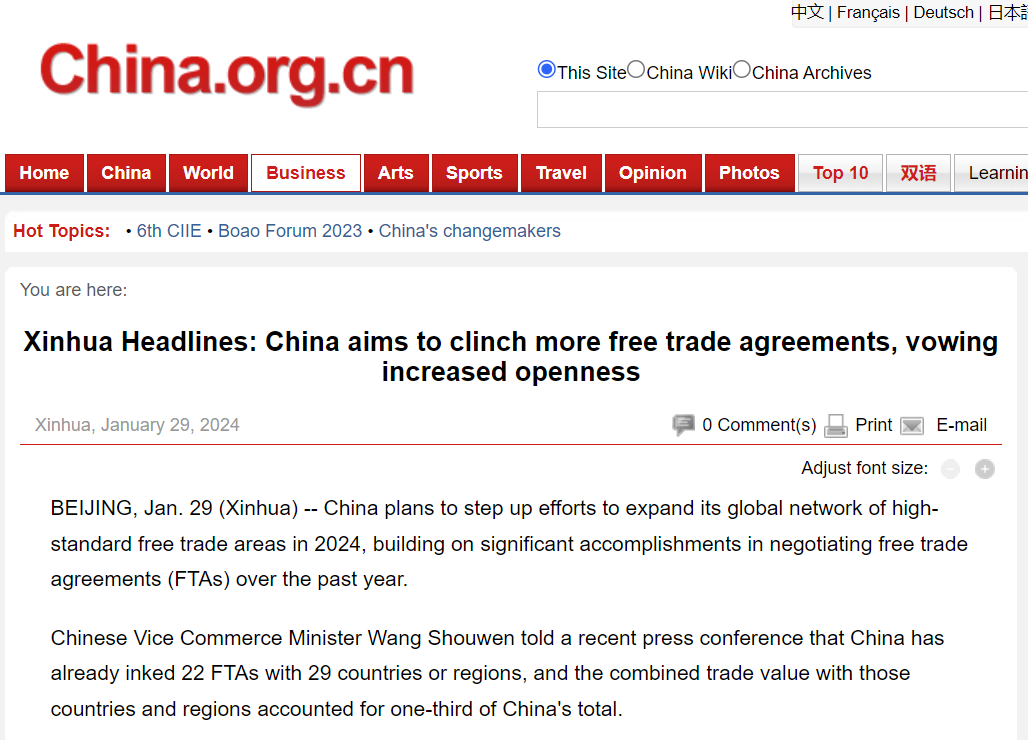LATEST INSIGHTS
Your Present Location: LATEST INSIGHTSWang Yiwei: Xinhua Headlines: China aims to clinch more free trade agreements, vowing increased openness
Source: China.org.cn Published: 2024-01-29

China plans to step up efforts to expand its global network of high-standard free trade areas in 2024, building on significant accomplishments in negotiating free trade agreements (FTAs) over the past year.
Chinese Vice Commerce Minister Wang Shouwen told a recent press conference that China has already inked 22 FTAs with 29 countries or regions, and the combined trade value with those countries and regions accounted for one-third of China's total.
In a move to further share China's opening-up dividends and power regional economic growth, China will enhance efforts regarding FTA negotiations in 2024, according to Wang. 'We have a full agenda for FTA negotiations this year,' he said.
TOWARD A BROADER FTA NETWORK
As negotiations for Version 3.0 of the China-ASEAN Free Trade Area are scheduled for this week in the eastern Chinese city of Hangzhou, Wang has vowed to exert efforts to conclude the talks this year.
The building of the China-ASEAN Free Trade Area was completed in 2010. According to customs data, trade between China and ASEAN since 2013 has logged an annual growth rate of 8.8 percent. In 2023, ASEAN was China's largest trading partner for the fourth straight year, while China held its position as ASEAN's largest partner for several years.
The two parties announced the official launch of the negotiations to upgrade the free trade area to its third version in November 2022, with the negotiations covering fields such as trade in goods, investment, digital and green economy to build a more inclusive, modern, comprehensive and mutually beneficial China-ASEAN FTA.
Experts believe that the upcoming version of the China-ASEAN Free Trade Area would also prompt the upgrade of the Regional Comprehensive Economic Partnership (RCEP).
It will be easier for the RCEP to leverage its coordinating and superimposing effects, following the leading example of the China-ASEAN Free Trade Area Version 3.0, said Wang Yiwei, a professor at Renmin University of China.
Apart from ASEAN, China also aims to complete the FTA negotiations with Honduras, and the negotiations involving the FTA upgrade with Peru this year. Advancements will be made in negotiations or upgrades of FTAs with the Gulf Cooperation Council, New Zealand, the Republic of Korea, and Switzerland, according to the vice minister.
On a broader scale, Wang Shouwen noted that China will continue its efforts to join the Comprehensive and Progressive Agreement for Trans-Pacific Partnership (CPTPP) and the Digital Economy Partnership Agreement (DEPA).
In an attempt to align with the CPTPP rules, China has introduced related documents and formulated reform measures to enhance institutional opening-up in Shanghai and other eligible regions. 'If the practices yield good outcomes, we will replicate them in other regions of China,' Wang Shouwen said.
TOWARD HIGH-STANDARD OPENNESS
In the past year, China committed to a negative-list model of services and investment opening-up by signing an FTA with Nicaragua and reaching a protocol to further upgrade the FTA with Singapore.
This marked a historic moment in China's FTA negotiation history, indicating that the country has reached a new level in advancing its FTA network toward high standards, according to Wang Shouwen.
Commenting on the FTA upgrade protocol with Singapore, Yuan Bo, a researcher with the Chinese Academy of International Trade and Economic Cooperation under the Ministry of Commerce, said services and investment are where the growth potentials of the two countries' future development reside. 'These two fields are the common interests of China and Singapore.'
Regarding RCEP cooperation, Yuan believes there is ample room for China to collaborate with RCEP members on consumer goods trade, cross-border e-commerce, service trade and investment, among other spheres.
China's foreign trade value with 14 RCEP members amounted to 12.6 trillion yuan (about 1.77 trillion U.S. dollars) in 2023, a 5.3 percent increase compared with that in 2021 before the agreement came into force, according to Wang Shouwen.
The pact has allowed Chinese trade companies to enjoy 2.36 billion yuan of tariff concessions for products imported from RCEP countries, while enterprises of RCEP countries benefited from 4.05 billion yuan of tax breaks for products imported from China in 2023.
'China is both a beneficiary of and a significant contributor to the enforcement of RCEP,' Yuan said.
Looking into this year, to further develop China's FTA network into a high-standard one, the country will continue to increase the proportion of zero-tariff products, push forward the comprehensive opening-up of service trade and investment with market-access negative lists, and include trade rules concerning digital economy, green economy, standard certification and government purchase into new FTA negotiations, Wang Shouwen said.
Key Words: Wang Yiwei, FTA, RCEP, CPTPP, DEPA























































































 京公网安备 11010802037854号
京公网安备 11010802037854号





